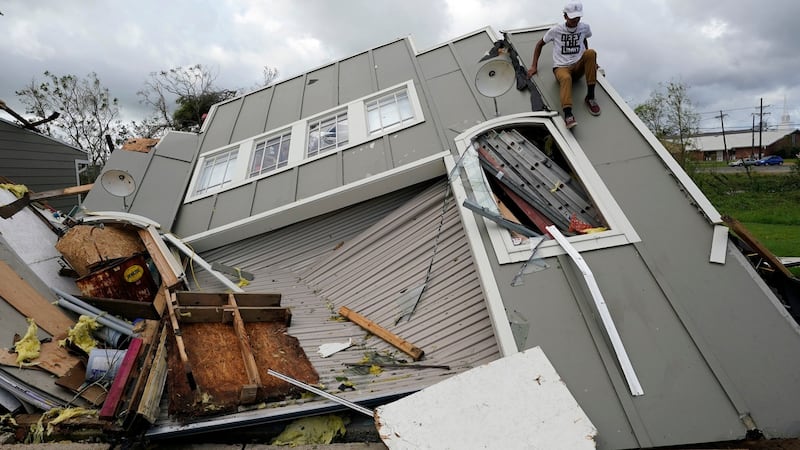Emergency fuel waivers have been issued for Louisiana and Mississippi in the United States due to Hurricane Ida, as officials warned it could be weeks before the power grid is repaired.
Ida, one of the most powerful hurricanes ever to hit the US Gulf Coast, knocked out power to more than one million homes in Louisiana on Monday and prompted rescue operations in flooded communities around New Orleans.
The fuel waiver, issued by the US Environmental Protection Agency, removes the Reid vapour pressure requirements "to help improve the fuel supply", and will remain in place until September 16th.
Rescuers in boats, helicopters and high-water trucks have brought hundreds of people trapped by Hurricane Ida’s floodwaters to safety after the storm swamped the Louisiana coast and ravaged the electrical grid.
Residents living amid the maze of rivers and bayous along the state’s Gulf Coast retreated desperately to their attics or roofs and posted their addresses on social media with instructions for search-and-rescue teams on where to find them.
As the storm was downgraded to a tropical depression on Monday afternoon and continued to make its way inland with torrential rain, it was blamed for at least two deaths – a motorist who drowned in New Orleans and a person hit by a falling tree outside Baton Rouge.
But with many roads impassable and cellphone service out in places, the full extent of its fury was still coming into focus.
Christina Stephens, a spokesperson for governor John Bel Edwards, said that given the level of destruction: "We're going to have many more confirmed fatalities."
The governor’s office said damage to the power grid appeared “catastrophic” – dispiriting news for those without refrigeration or air conditioning during the dog days of summer.
Mr Edwards told a news conference: “There are certainly more questions than answers. I can’t tell you when the power is going to be restored. I can’t tell you when all the debris is going to be cleaned up and repairs made.
“But what I can tell you is we are going to work hard every day to deliver as much assistance as we can.”

Local, state and federal rescuers combined to save at least 671 people by Monday afternoon, he said.
In hard-hit LaPlace, squeezed between the Mississippi River and Lake Pontchartrain, rescuers saved people from flooded homes in a near-constant operation.
The hurricane blew ashore on the 16th anniversary of Katrina, the 2005 storm that breached New Orleans’ levees, devastated the city and was blamed for 1,800 deaths.
This time, New Orleans appeared to escape the catastrophic flooding city officials had feared.
The city urged people who evacuated to stay away for at least a couple of days because of the lack of power and fuel.
"There's not a lot of reasons to come back," said Collin Arnold, chief of emergency preparedness.
Damage
Also, 18 water systems serving about 255,000 customers in Louisiana were knocked out of service, the state health department said.
Four Louisiana hospitals were damaged and 39 medical facilities were operating on generator power, the Federal Emergency Management Agency said. Officials said they were evacuating scores of patients to other cities.
The governor’s office said more than 2,200 evacuees were staying in 41 shelters, a number expected to rise as people were rescued or escaped flooded homes.
Preliminary measurements showed Slidell, Louisiana, got at least 15.7 inches of rain, while New Orleans received nearly 14 inches, forecasters said. Other parts of Louisiana and Mississippi, Alabama and Florida got five to 11 inches.
The Louisiana National Guard said it activated 4,900 personnel and lined up 195 high-water vehicles, 73 rescue boats and 34 helicopters.
Local and state agencies were adding hundreds more. Mr Edwards said he decided not to tour hurricane damage by air on Monday to add one more aircraft to the effort.
Outages
The hurricane twisted and collapsed a giant tower that carries key transmission lines over the Mississippi River to the New Orleans area, causing widespread outages, Entergy and local authorities said.
The power company said more than 2,000 miles of transmission lines were out of service, along with 216 substations. The tower had survived Katrina.
The storm also flattened utility poles, toppled trees on to power lines and caused transformers to explode.
The governor said 25,000 utility workers were in the state to help restore electricity, with more on the way.
Mr Edwards said: “We’re going to push Entergy to restore power just as soon as they can.”
Phone company AT&T said its wireless network in Louisiana was reduced to 60 per cent of normal but was coming back. Many people resorted to using walkie-talkies.
Ida’s 230km/h winds tied it for the fifth-strongest hurricane ever to hit the mainland. Its winds were down to 64km/h around midday on Monday.
In Mississippi’s southwestern corner, entire neighbourhoods were surrounded by floodwaters, and many roads were impassable.
Several tornadoes were reported, including a suspected twister in Saraland, Alabama, that ripped part of the roof off a motel and flipped an 18-wheeler, injuring the driver, according to the National Weather Service.
Ida was expected to pick up speed on Monday night before dumping rain on the Tennessee and Ohio River valleys on Tuesday, the Appalachian mountain region on Wednesday and the nation's capital on Thursday.
Forecasters said flash flooding and mudslides were possible along Ida's path before it blows out to sea over New England on Friday. – Associated Press, Reuters











